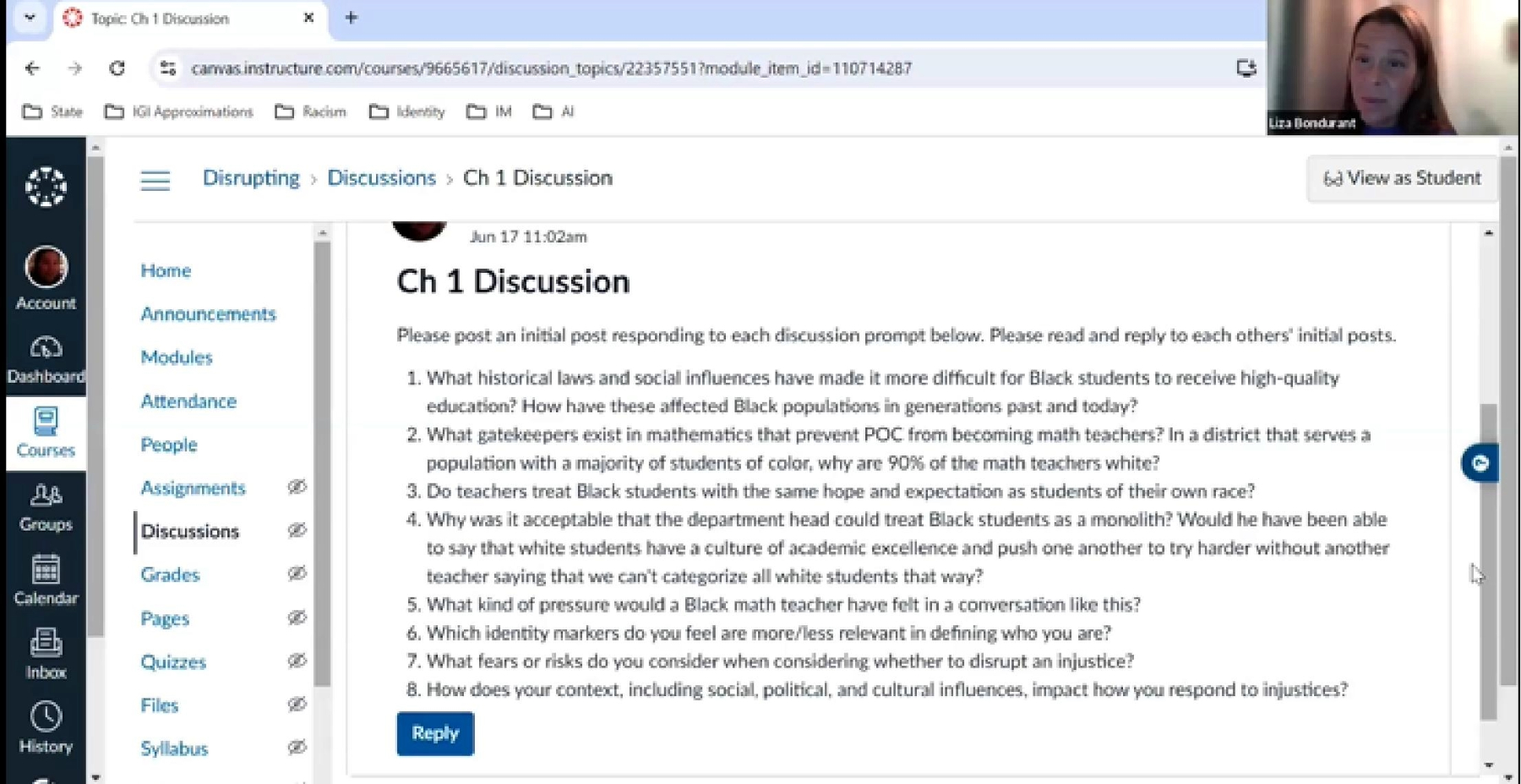Self-Recording Teaching Using Video Conferencing Platforms: Enhancing Reflection and Practice
Self-Recording Teaching Using Video Conferencing Platforms: Enhancing Reflection and Practice
How often do you use video conferencing platforms (VCPs) to self-record your online teaching so you can reflect on your practice afterward? How often do you encourage the teachers you work with, whether preservice or in-service, to self-record their online teaching using VCPs? Mathematics teacher educators (MTEs) and the teachers they support can use self-recorded teaching videos to reflect on, set goals, and improve their instructional practices. Building on van Es and colleagues (2015), we explored how VCPs, like Zoom, can extend the benefits of self-captured video. van Es and colleagues discussed key considerations for effective self-recording that we argue are still relevant when using VCPs, including camera positioning, video length, and task specification. Reflecting on our practice, we found that VCP-specific features offer additional opportunities to self-reflect and promote more meaningful online classroom interactions. These features may enhance self-recorded videos and help educators analyze details about their moves, student participation, and mathematical discourse. We highlight how MTEs could strategically use VCPs, a conveyance technology (Dick & Hollebrands, 2011), to optimize the usefulness of self-recorded online teaching videos by discussing potential affordances and constraints of key Zoom features. Before recording, educators must inform students and obtain their permission.
Speaker View
Speaker View highlights the active speaker during a recorded session. It isolates and enhances the clarity of the speaker’s nonverbal utterances, such as facial expressions and gestures. Facial expressions can provide clues about student engagement and understanding. For example, a student may nod or hold their thumb up to indicate they understand, while a student who does not understand may display a puzzled facial expression or scratch their head. Moreover, a student who is unable to articulate their thinking verbally may express their understanding using gestures. However, although this view is ideal for analyzing the speaker’s discourse moves, we consider it insufficient for capturing multiple students’ nonverbal utterances.
Gallery View
Gallery View displays all participants with cameras on and the names of those with their cameras off. This feature is valuable for analyzing the nonverbal utterances of all students in the class. Additionally, educators interested in analyzing equitable participation can use Gallery View to track who participates, when, and how (Reinholz & Shah, 2018). However, in large classes, video thumbnails may be too small to capture detailed expressions or gestures. We recommend Gallery View for smaller classes or paired with chat or breakout room recordings.
Figure 1
Gallery View

Screen Sharing with Speaker View
Screen Sharing with Speaker View allows educators or students to share visual materials, such as digital manipulatives, dynamic geometry tools, or problem-solving strategies, while simultaneously displaying a small video of the speaker. Thus, this view is ideal for displaying multiple mathematical representations and solution strategies. However, only one participant can share their screen at a time, and only the speaker’s camera is visible in the recording.
Figure 2
Screen Sharing with Speaker View
Note. Discussion prompts in this figure are from Id-Deen, L., & Song, E. (2023). Disrupting injustice: Navigating critical moments in the classroom. National Council of Teachers of Mathematics.

Breakout Rooms
Breakout Rooms allow educators to reflect on student collaboration in small groups. While Zoom does not record multiple rooms simultaneously, participants can record locally and share recordings. Small groups can provide more opportunities for students to share their thinking. To get a comprehensive view of student thinking, educators could analyze recordings of the breakout room discussions in concert with the whole-class discussions and chat discussions. However, organizing multiple recordings requires planning, and educators should provide clear instructions on saving and sharing files.
AI Note-Taking
AI Note-Taking summarizes class discussions. While these tools highlight key themes, they may misinterpret mathematical language, symbols, or technical vocabulary. We recommend educators use AI summaries as a starting point rather than a complete record. When paired with the full transcription from the video recording, the summary can help educators efficiently identify moments for deeper analysis.
Chat
The Chat feature captures written participation, particularly from students who may be hesitant to speak. Saved chat transcripts record student questions and responses that may not be verbalized. This can benefit multilingual learners or students who prefer writing. However, chat transcripts may include off-topic comments or require extensive review to extract meaningful contributions. Combining chat transcripts with video transcripts can provide a fuller understanding of student thinking and participation. Table 1 illustrates a hypothetical interaction between an MTE and three preservice teachers.
Table 1
Zoom Transcript Merged with Chat Transcript
| MTE | Let’s discuss how you might use the Five Practices when analyzing these student work samples on quadratic equations. How would you approach Selecting and Sequencing student responses to highlight key mathematical ideas? |
| PST 1
|
I think I’d start by looking for different ways students approached the problem, like whether they factored, used the quadratic formula, or completed the square. |
| PST 2
|
Agreed! Some students might graph first, which could be a useful entry point for discussion. |
| PST 3 (in chat)
|
I’d worry about sequencing in a way that makes sense to students. Like, should I go from least to most sophisticated? Or from common errors to correct responses? |
| MTE
|
PST 3 posed a great question in the chat. There’s research suggesting that both approaches can be effective, depending on the goals. What do you all think? |
| PST 2
|
I like the idea of starting with common misconceptions. That way, we can address them explicitly before moving to the correct solutions. |
| PST 1
|
I usually think about building toward the big idea. So, if I want students to see connections between factoring and the quadratic formula, I might arrange the work to show how those strategies relate. |
| PST 3 (in chat) | I hadn’t thought about how the sequencing connects different methods. That makes sense! |
| MTE | Thank y’all for participating, aloud and in the chat. |
Conclusion
Self-recording alone does not ensure teaching improvement (Tekkumru-Kisa & Stein, 2017), but the intentional use of VCP-specific features can enhance reflection and inspire goal-setting. Building on van Es and colleagues (2015), we encourage educators to define clear goals for video review and select VCP features accordingly. Using VCPs features to self-record online teaching can help educators interested in exploring student engagement, refining their questioning, or analyzing online classroom discourse. These recordings can focus on MTEs’ own teaching or on the instructional practices of the teachers they support. Experimenting with VCP features and reflecting on their affordances positions MTEs and teachers to analyze and improve instruction, ultimately enhancing student learning.
References
Dick, T. P., & Hollebrands, K. F. (2011). Focus in high school mathematics: Technology to support reasoning and sense making (pp. xi-xvii). Reston, VA: National Council of Teachers of Mathematics.
Reinholz, D. L., & Shah, N. (2018). Equity analytics: A methodological approach for quantifying participation patterns in mathematics classroom discourse. Journal for Research in Mathematics Education, 49(2), 140-177. https://doi.org/10.5951/jresematheduc.49.2.0140
Tekkumru-Kisa, M., & Stein, M. K. (2017). A framework for planning and facilitating video-based professional development. International Journal of STEM education, 4, 1-18. https://doi.org/10.1186/s40594-017-0086-z
van Es, E. A., Stockero, S. L., Sherin, M. G., Van Zoest, L. R., & Dyer, E. (2015). Making the most of teacher self-captured video, Mathematics Teacher Educator, 4(1), 6-19. https://doi.org/10.5951/mathteaceduc.4.1.0006
